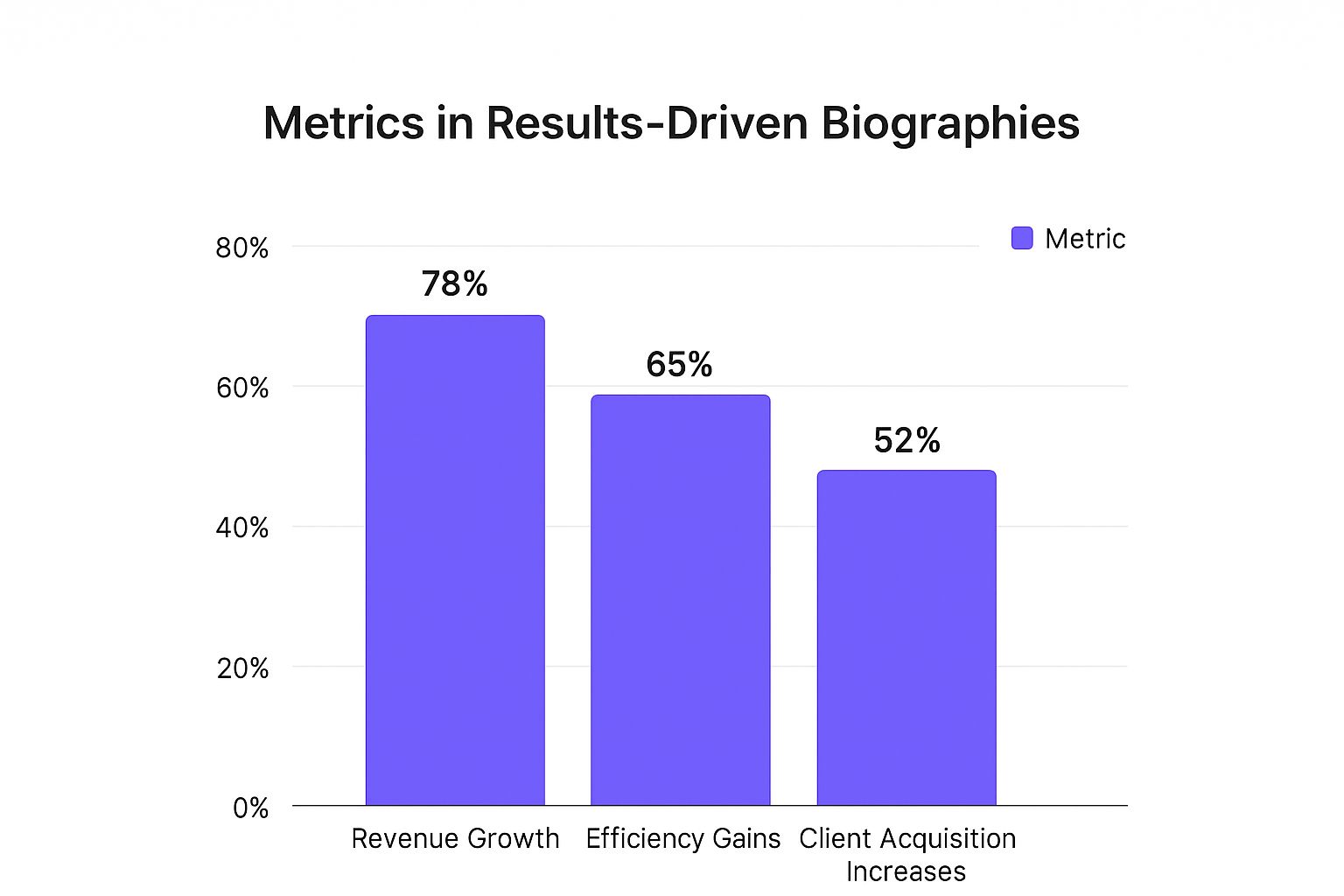7 Professional Bio Examples That Work in 2025

Beyond the Resume: Why Your Professional Bio is Your Most Powerful Career Tool
Your professional bio is more than a summary; it's a strategic tool that shapes perception, builds trust, and opens doors to opportunity. A generic list of accomplishments from your resume is no longer enough to make an impact. To stand out, you need a compelling narrative that showcases your expertise while connecting with your target audience on a human level. A well-crafted bio can be the deciding factor for a potential client, employer, or collaborator.
This article moves beyond basic templates to provide a strategic breakdown of diverse professional bio examples. We will dissect seven distinct bio archetypes, uncovering the storytelling techniques and psychological triggers that make them so effective. You will learn not just what to write, but why specific approaches work, gaining actionable insights to craft a bio that actively accelerates your professional goals.
We will explore everything from results-driven formats that command respect to narrative arcs that build lasting connections. Get ready to learn the replicable strategies behind powerful bios, equipping you to define your personal brand and make an unforgettable first impression. Let's dive into the examples that will transform how you present yourself professionally.
1. The Narrative Arc Bio
The Narrative Arc Bio transforms a standard list of accomplishments into a compelling story. Instead of merely stating what you’ve done, this approach frames your career as a meaningful journey, complete with challenges, pivotal moments, and significant growth. It connects with readers on an emotional level by structuring your professional history like a narrative, making your experience more memorable and impactful. This is one of the most powerful professional bio examples for building a personal brand.

This method is particularly effective for founders, career changers, or anyone with a non-linear path. Consider the bio of Sara Blakely, founder of Spanx. Her story isn’t just about creating a billion-dollar company; it’s about her journey from selling fax machines door-to-door, facing rejection from manufacturers, and using her life savings to launch a product she believed in. This narrative arc makes her success feel earned and relatable.
Strategic Breakdown
The core strategy is to create an emotional connection. People remember stories far better than they remember lists of facts. By presenting your career as a narrative, you highlight your resilience, problem-solving skills, and vision in a way that a simple resume cannot.
- The "Why": It establishes your motivation and passion. Why did you start? What problem drove you?
- The "How": It showcases your resourcefulness and tenacity. How did you overcome obstacles?
- The "What": It gives context to your achievements. What was the ultimate result of your journey?
Actionable Takeaways
To craft your own narrative arc bio, follow these steps:
- Identify Key Turning Points: Don't list every job. Focus on 2-3 pivotal moments or transitions that define your career path.
- Establish the "Before": Briefly describe your starting point. This creates a baseline for your growth. (e.g., "Starting my career in a completely different field...")
- Showcase the Climax: Detail the core challenge or opportunity you faced and how you tackled it. Weave in specific achievements and metrics here. (e.g., "...I identified a gap in the market, leading me to develop a solution that increased user engagement by 300%.")
- Conclude with Your Current Vision: End by stating your current role and what you aim to achieve next, connecting your past journey to your future goals.
2. The Results-Driven Achievement Bio
The Results-Driven Achievement Bio cuts straight to the point by leading with quantifiable success. Instead of telling a story, this format proves your value using hard data, specific metrics, and concrete outcomes. It positions you as a high-impact professional by immediately showcasing what you have accomplished in measurable terms. For executives, consultants, and professionals in performance-based fields, this is one of the most effective professional bio examples to demonstrate tangible expertise.
This approach is highly prevalent among Fortune 500 executives and top-tier management consultants. For instance, a COO's bio might lead with "Grew annual recurring revenue by $150M," or a consultant's profile on a McKinsey & Company site might highlight how they "achieved a 40% reduction in operational costs for a global logistics client." This method removes ambiguity and communicates your ability to deliver results in a language that decision-makers understand and respect.
The bar chart below illustrates the most common metrics featured in results-driven bios, showing a clear preference for metrics tied directly to financial performance and operational efficiency.

This data reveals that highlighting revenue growth is the most powerful tactic, as it directly correlates with core business objectives, followed closely by demonstrating improvements in efficiency.
Strategic Breakdown
The core strategy here is to build immediate credibility and authority. By front-loading your bio with impressive numbers, you anchor your professional identity to success. This method is exceptionally powerful because metrics are universally understood and difficult to dispute, making your claims more potent.
- The "What": It answers the question, "What tangible value did you create?" with specific, undeniable proof.
- The "How Much": It quantifies the impact, providing a clear scale of your achievements (e.g., millions in revenue, percentage points in efficiency).
- The "For Whom": It adds context by mentioning the type of company or client you delivered results for, enhancing your relevance.
Actionable Takeaways
To build your own results-driven bio, use these steps:
- Identify Your "Headline" Number: Review your accomplishments and find the single most impressive metric. This could be a revenue figure, a percentage increase, or a cost-saving amount. Lead with this.
- Use Powerful Action Verbs: Start your sentences with dynamic verbs like "Generated," "Increased," "Reduced," "Optimized," or "Spearheaded" to convey proactivity and ownership.
- Provide Essential Context: A number without context is meaningless. Always include the timeframe (e.g., "...in under 12 months") or the scale (e.g., "...for a Fortune 100 enterprise") to frame your achievement.
- Connect Results to Your Role: Conclude by summarizing your current role and how you leverage this results-oriented approach to drive future success, linking past performance to your present value.
3. The Expertise-Authority Bio
The Expertise-Authority Bio is designed to establish you as a go-to expert and thought leader in your field. This approach moves beyond listing job titles and instead focuses on tangible proof of your knowledge, such as publications, speaking engagements, awards, and media features. It’s a direct and powerful way to build credibility by showcasing your intellectual contributions and third-party validation. This is one of the most effective professional bio examples for consultants, academics, and technical specialists.

This style is common among figures like author Malcolm Gladwell, whose bios often lead with his status as a multiple New York Times bestselling author and staff writer for The New Yorker. The emphasis is on his recognized contributions to public discourse, not just his employment history. Similarly, professors' bios on university websites highlight specific research areas, published papers, and academic honors to cement their authority within a specialized discipline. The goal is to answer the question, "Why should I listen to you?" with undeniable evidence.
Strategic Breakdown
The core strategy is to build trust through credentials and social proof. By highlighting verifiable achievements and recognition from respected sources, you remove doubt and position yourself as a reliable authority. This bio format works by prioritizing evidence of expertise over a personal story.
- The "Why": It demonstrates deep commitment to a field. Why are you the expert? Because of your dedicated research, published works, and industry recognition.
- The "How": It provides concrete evidence. How do we know you're an authority? Through your TED talks, bestselling books, or keynotes at major conferences.
- The "What": It defines your specific niche. What is your area of mastery? This bio clearly states your specialized knowledge, such as "an expert in consumer psychology" or "a leading voice in sustainable technology."
Actionable Takeaways
To write your own Expertise-Authority Bio, focus on accumulating and presenting proof:
- Lead with Your Strongest Credential: Start with your most impressive and recognizable achievement, whether it's an award, a major publication, or a significant media mention (e.g., "Featured in Forbes..." or "Author of the award-winning book...").
- Quantify Your Influence: Use numbers to add weight to your claims. Mention the number of copies your book sold, the size of the audience at your keynote, or the reach of a publication you wrote for.
- Use Third-Party Validation: Explicitly name the institutions that have recognized you. Mentioning "Harvard Business Review," "TEDx," or specific industry awards adds a layer of objective credibility that self-proclamations lack.
- Connect Expertise to Your Current Role: Conclude by linking your authority to what you currently do. For example, "...she now uses her expertise in data analytics to help Fortune 500 companies drive growth."
4. The Personal Brand Bio
The Personal Brand Bio masterfully blends professional expertise with personal values, interests, and personality. Instead of focusing solely on career milestones, this approach creates a multi-dimensional portrait that makes you more relatable, memorable, and distinct. It’s about building a brand around who you are, not just what you've accomplished, which can be a powerful differentiator in a crowded field. This is one of the most effective professional bio examples for entrepreneurs and creators.

This style is perfectly suited for social media influencers, lifestyle entrepreneurs, and consultants whose business is intrinsically tied to their identity. Consider Marie Forleo, who seamlessly integrates her background in dance and life philosophy with her work as a business coach. Her bio isn't just about business; it's about a holistic approach to life, making her brand aspirational and authentic. Similarly, Tim Ferriss connects his experiments in lifestyle optimization to his success in business and investing, creating a unique and compelling brand.
Strategic Breakdown
The core strategy is to humanize your professional identity to foster a stronger, more loyal connection with your audience. By sharing relevant personal details, you allow people to connect with you on a deeper level, building trust that transcends a simple transactional relationship.
- The "Why": It reveals the core values and passions that drive your professional work.
- The "How": It shows how your unique life experiences and interests shape your professional approach.
- The "What": It presents a holistic picture, showcasing you as an expert with a relatable personality.
Actionable Takeaways
To build your own personal brand bio, follow these steps:
- Identify Your Brand Pillars: List 3-5 core themes that define you. Combine professional expertise (e.g., "digital marketing") with personal passions (e.g., "minimalism" or "marathon running").
- Find the Intersection: Articulate how your personal interests inform your professional value. (e.g., "My discipline as a marathon runner translates into the relentless focus I bring to my clients' marketing campaigns.")
- Weave in Personality: Use a voice that reflects your true personality. If you're witty, let it show. If you're more philosophical, embrace that tone. Start by stating your professional role and then pivot to what makes you unique.
- Keep it Relevant: Ensure any personal details shared are appropriate and reinforce your professional brand. The goal is to enhance your credibility, not detract from it.
5. The Problem-Solution Bio
The Problem-Solution Bio directly addresses a reader's pain point and positions you as the definitive expert to solve it. Instead of leading with your job title or accomplishments, this format opens by identifying a common, pressing challenge within your industry. It immediately grabs the attention of your target audience by showing you understand their struggles and then seamlessly presents your skills and experience as the most effective resolution. This is one of the best professional bio examples for consultants and service-based professionals.
This approach is highly effective for B2B service providers, IT consultants, and business coaches. For instance, a cybersecurity consultant's bio might start by highlighting the growing threat of ransomware attacks on small businesses. It would then detail their proprietary method for securing networks and showcase a track record of preventing breaches. This structure instantly communicates value and filters for qualified leads who are actively seeking a solution to that specific problem.
Strategic Breakdown
The strategy here is to establish immediate relevance and build trust. By articulating the problem better than the reader can themselves, you demonstrate deep expertise and empathy. This makes your proposed solution more credible and compelling, moving you from a generalist to a specialized problem-solver in the reader's mind.
- The Problem: It hooks the reader by naming their specific challenge or fear. Why do they need help?
- The Agitation: It briefly expands on the negative consequences of the problem if left unsolved. What’s at stake?
- The Solution: It introduces you and your unique methodology as the clear path forward. How do you fix it?
Actionable Takeaways
To build a powerful problem-solution bio, use this framework:
- Define the Core Problem: Research your ideal client's biggest pain point. State it clearly and concisely in your opening sentence. (e.g., "Many startups struggle to convert early adopters into paying customers.")
- Quantify the Stakes: Briefly mention the negative impact. This creates urgency. (e.g., "...burning through cash reserves and stalling growth.")
- Introduce Your Solution: Present your role and unique approach as the answer. Frame your services as the solution to the problem you just outlined. (e.g., "As a growth marketing consultant, I implement a proprietary framework that builds sustainable revenue streams...")
- Provide Proof: Conclude with a specific, metric-driven result or a brief case study to validate your claims. (e.g., "...helping SaaS companies like [Client Name] increase their customer lifetime value by 40% in six months.")
6. The Journey and Transformation Bio
The Journey and Transformation Bio builds trust by showcasing a professional's own significant personal or professional change. It frames their expertise not just on academic knowledge, but on lived experience, demonstrating that they have successfully navigated the same challenges their clients now face. This bio format is incredibly persuasive for coaches, consultants, and service providers whose work is centered on guiding others through a similar metamorphosis.
This approach goes beyond a simple success story. It highlights the "before" state of struggle, the process of change, and the "after" state of achievement. Consider a career coach who transitioned from a soul-crushing corporate job to a fulfilling entrepreneurial venture. By detailing this journey, they prove their ability to guide others, making their advice more authentic and credible than someone who has never made such a leap. This is one of the most effective professional bio examples for building deep client rapport.
Strategic Breakdown
The core strategy here is empathy through shared experience. This bio says, "I understand where you are because I've been there myself." It creates an immediate bond and positions the professional not just as an expert, but as a guide who knows the path intimately, including its pitfalls and shortcuts.
- The "Before": It establishes a relatable starting point of pain or dissatisfaction that mirrors the client's current situation.
- The "Journey": It details the pivotal steps, mindset shifts, and key lessons learned during the transformation. This is where expertise is demonstrated.
- The "After": It presents the successful outcome, not just for the professional, but as a tangible possibility for the client.
Actionable Takeaways
To write a compelling journey and transformation bio, use this framework:
- Define Your "Before" State: Be vulnerable and specific about the problem you faced. (e.g., "I was stuck in a career that left me drained and uninspired," or "I struggled for years with inconsistent client acquisition.")
- Detail the Turning Point: Pinpoint the moment you decided to change and the first steps you took. This is the heart of your story.
- Showcase the "How" with Lessons: Explain the process and, more importantly, the lessons you learned that now form the basis of your coaching or service. Frame these as benefits for your client. (e.g., "Through this process, I developed a three-step framework for identifying your core career values, which I now use to help my clients find clarity.")
- Connect to Your Current Mission: Conclude by explicitly linking your journey to your current work, stating how your experience equips you to help others achieve their own transformation.
7. The Industry Insider Bio
The Industry Insider Bio positions you not just as a participant in your field, but as a deeply embedded authority figure. It leverages sector-specific jargon, key relationships, and niche expertise to signal that you are a true veteran who understands the nuances of the industry from the inside out. This approach goes beyond listing accomplishments to demonstrate a mastery of the industry's culture, trends, and key players.
This format is essential for professionals in fields where relationships and deep-seated knowledge are paramount, like investment banking, entertainment, or specialized tech sectors. For example, a tech executive's bio might mention their early days in Silicon Valley and connections to foundational companies. Similarly, an entertainment agent’s bio would emphasize their deep-rooted relationships in Hollywood. These details serve as powerful social proof of their influence and expertise.
Strategic Breakdown
The core strategy here is to build credibility through exclusivity and specialized knowledge. By speaking the language of your industry, you create an immediate bond with peers and signal to outsiders that you possess insights they cannot easily access. This makes you a go-to source for high-level opportunities, commentary, and partnerships.
- The "Where": It establishes your presence within the industry's most important circles (e.g., Wall Street, Silicon Valley, Hollywood).
- The "Who": It showcases your network and the influential people you've worked with, implying a high level of trust and respect.
- The "What's Next": It demonstrates your grasp of the industry's trajectory by offering forward-looking perspectives.
Actionable Takeaways
To write a compelling industry insider bio, follow these steps:
- Name-Drop Strategically: Mention influential companies, key projects, or well-respected leaders you've worked with. This acts as a powerful endorsement of your skills.
- Use Industry-Specific Language: Incorporate terminology and acronyms common in your field. This demonstrates fluency and immediately identifies you as a peer to other insiders.
- Highlight Niche Achievements: Focus on accomplishments that would only be recognized and valued by someone within your industry, such as securing a specific type of funding or winning a sector-specific award.
- Share a Forward-Looking Insight: Conclude by offering a brief prediction or observation about the future of your industry. This positions you as a thought leader who is shaping what's to come.
Professional Bio Style Comparison of 7 Examples
| Bio Type | Implementation Complexity 🔄 | Resource Requirements 💡 | Expected Outcomes 📊 | Ideal Use Cases 💡 | Key Advantages ⭐ |
|---|---|---|---|---|---|
| The Narrative Arc Bio | Medium - requires strong writing skills and editing 🔄🔄 | Moderate - storytelling ability, time for revisions 💡 | Emotional connection, memorable impression 📊📊 | Entrepreneurs, creative professionals, public speakers, authors 💡 | Humanizes professional, demonstrates resilience, engaging story ⭐⭐ |
| The Results-Driven Achievement Bio | Medium - needs access to accurate metrics and data 🔄🔄 | High - requires data collection and regular updates 💡 | Establishes credibility, easy to scan, ROI-focused 📊📊📊 | Executives, sales professionals, consultants, financial advisors 💡 | Immediate credibility, data-driven appeal, clear value demonstration ⭐⭐⭐ |
| The Expertise-Authority Bio | High - requires extensive credentials and validation 🔄🔄🔄 | High - needs proof of expertise, media mentions, publications 💡 | Builds trust, attracts premium opportunities 📊📊 | Consultants, academics, authors, speakers 💡 | Establishes thought leadership, supports premium pricing, SEO boost ⭐⭐⭐ |
| The Personal Brand Bio | Medium - balance personal and professional tone 🔄🔄 | Moderate - self-awareness and content marketing skills 💡 | Differentiation, authentic connections, aligned opportunities 📊📊 | Entrepreneurs, coaches, creative pros, personal service providers 💡 | Strong differentiation, builds authenticity, supports content marketing ⭐⭐ |
| The Problem-Solution Bio | Medium - requires deep market understanding 🔄🔄 | Moderate - research audience pain points and case studies 💡 | Clear value proposition, target audience relevance 📊📊 | Consultants, service providers, coaches, technical specialists 💡 | Communicates value clearly, appeals to action-oriented clients, differentiation ⭐⭐ |
| The Journey and Transformation Bio | Medium - needs vulnerability and storytelling 🔄🔄 | Moderate - time for personal story crafting, client case studies 💡 | Emotional connection, mentor positioning, growth appeal 📊📊 | Life coaches, career counselors, health pros, personal trainers 💡 | Creates empathy, inspires prospects, positions as guide ⭐⭐ |
| The Industry Insider Bio | Medium - requires up-to-date industry knowledge 🔄🔄 | Moderate - ongoing industry engagement and networking 💡 | Industry credibility, business development, network leverage 📊📊 | Industry specialists, sector consultants, trade leaders, analysts 💡 | Builds immediate industry trust, leverages network, deep sector insight ⭐⭐ |
Crafting Your Ultimate Bio: Synthesis and Action
We’ve journeyed through a comprehensive gallery of professional bio examples, dissecting everything from the Narrative Arc Bio to the Industry Insider Bio. The most crucial insight to take away is that a truly powerful bio is never a static document; it’s a dynamic strategic asset tailored to a specific audience, platform, and goal. The examples we analyzed are not rigid templates but flexible frameworks. They are the building blocks you can combine and customize to create a bio that is authentically and effectively you.
The key to unlocking their power lies in synthesis. A great bio doesn't just pick one strategy; it blends the best elements of several. Think of it as a recipe where you are the head chef, deciding on the perfect mix of ingredients to achieve a desired outcome.
Your Strategic Synthesis Blueprint
To move from inspiration to implementation, you must first define your core components. The most effective professional bios are built on a foundation of self-awareness and strategic intent. Start by asking yourself three fundamental questions:
- What is my primary objective? Is it to attract recruiters on LinkedIn, secure speaking engagements, build client trust on a consulting website, or establish authority in a niche community? Your goal dictates your focus.
- Who is my primary audience? A bio written for a venture capitalist will sound vastly different from one written for potential freelance clients in the creative arts. Tailor your language, tone, and the evidence you present to resonate with their specific needs and expectations.
- What are my core differentiators? This is where you combine the frameworks we've discussed. Pinpoint your most compelling achievements (Results-Driven), your unique career path (Journey and Transformation), and the core problem you solve for others (Problem-Solution).
Actionable Next Steps: From Framework to First Draft
With your strategic blueprint in hand, it's time to build. Don’t aim for perfection in the first draft. Instead, focus on assembling the raw materials.
- List Your "Greatest Hits": Jot down your top 3-5 quantifiable achievements. Use hard numbers, percentages, and specific outcomes. This is the bedrock of your Results-Driven elements.
- Outline Your Story Arc: What was the inciting incident of your career? What challenges did you overcome? What transformation did you undergo? This forms the spine of your Narrative or Journey bio.
- Define Your "Why": Clearly articulate the problem you are passionate about solving. Frame it from the perspective of your target audience. This is the core of your Problem-Solution framework.
By viewing the professional bio examples in this article as a collection of strategic tools rather than just finished products, you empower yourself to build a profile that does more than list your accomplishments. It tells a compelling story, builds immediate trust, and clearly communicates the unique value you offer. Mastering this skill is a career supercharger, opening doors to opportunities you may not have even known existed.
Ready to stop staring at a blank page and start crafting a bio that truly performs? MakerBox leverages advanced AI trained on thousands of high-converting profiles to help you generate dozens of tailored bio variations in seconds. Test different tones, frameworks, and styles to find the perfect synthesis for your brand.





